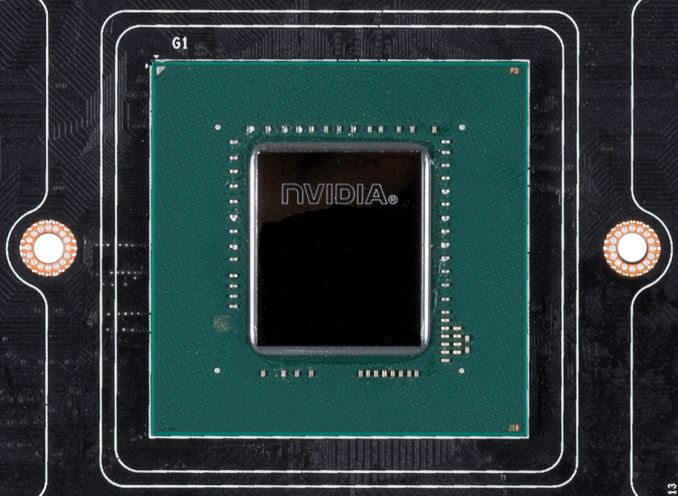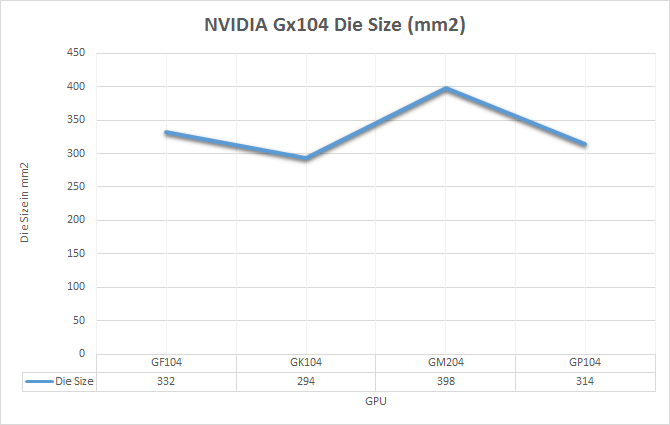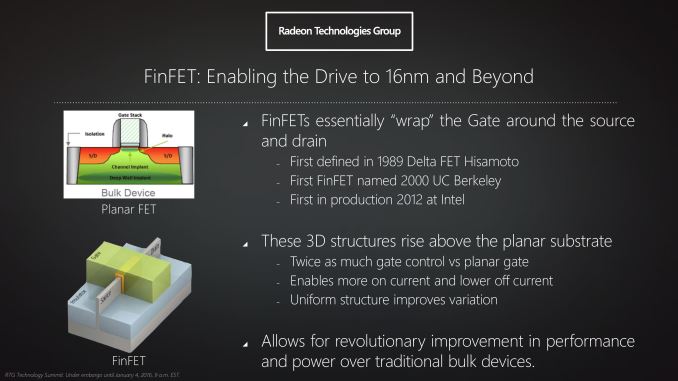The NVIDIA GeForce GTX 1080 & GTX 1070 Founders Editions Review: Kicking Off the FinFET Generation
by Ryan Smith on July 20, 2016 8:45 AM ESTGP104: The Heart of GTX 1080
At the heart of the GTX 1080 is the first of the consumer-focused Pascal GPUs, GP104. Though no two GPU generations are ever quite alike, GP104 follows a number of design cues established with the past couple 104 GPUs. Overall 104 GPUs have struck a balance between size and performance, allowing NVIDIA to get a suitably high yielding GPU out at the start of a generation, and to be followed up with larger GPUs later on as yields improve. With the exception of the GTX 780, 104 GPUs been the backbone of NVIDIA’s GTX 70 and 80 parts, and that is once again the case for the Pascal generation.
In terms of die size, GP104 comes in at 314mm2. This is right in NVIDIA’s traditional sweet spot for these designs, slotting in between the 294mm2 GK104 and the 332mm2 GF104. In terms of total transistors we’re looking at 7.2B transistors, up from 3.5B on GK104 and the 5.2B of the more unusual GM204. The significant increase in density comes from the use of TSMC’s 16nm FinFET process, which compared to 28nm combines a full node shrink, something that has been harder and harder to come by as the years have progressed.
Though the density improvement offered by TSMC’s 16nm process is of great importance to GP104’s overall performance, for once density takes a back seat to the properties of the process itself. I am of course speaking about the FinFET transistors, which are the headlining feature of TSMC’s process.
We’ve covered FinFET technology in depth before, so I won’t completely rehash it here. But in brief, FinFETs are an important development for chip fabrication as processes have gone below 28nm. As traditional, planar transistors have shrunk in feature size – and ultimately, the number of atoms they’re comprised of – electrical leakage has increased. With fewer atoms in a transistor, there are equally fewer atoms to control the flow of electrons.
FinFET in turn is a solution to this problem, essentially allowing fabs to turn back the clock on electrical leakage. By building transistors as three-dimensional objects with height as opposed to two-dimensional objects, giving FinFET transistors their characteristic fins in the process, FinFET technology greatly reduces the amount of energy a transistor leaks. In practice what this means is that FinFET technology not only reduces the total amount of energy wasted from leakage, but it also allows transistors to be operated at a much lower voltage, something we’ll see in depth with our analysis of GTX 1080.
FinFETs, or rather the lack thereof, are a big part of why we never saw GPUs built on TSMC’s 20nm process. It was TSMC’s initial belief that they could contain leakage well enough using traditional High-K Metal Gate (HKMG) technology on 20nm, a bet they ultimately lost. At 20nm, planar transistors were just too leaky to use for many applications, which is why ultimately we only saw SoCs on 20nm (and even then they were suboptimal). FinFETs, as it turns out, are absolutely necessary to get good performance out of transistors built on processes below 28nm.
And while it took TSMC some time to get there, now that they have the capability NVIDIA can reap the benefits. Not only can NVIDIA finally build a relatively massive chip like a GPU on a sub-28nm process, but thanks to the various beneficial properties of FinFETs, it allows them to take their designs in a different direction than what they could do on 28nm.













200 Comments
View All Comments
Matt Doyle - Wednesday, July 20, 2016 - link
Same page, "The latter is also a change from GTX 980, as NVIDIA has done from a digital + analog DVI port to a pure digital DVI port.""NVIDIA has gone"?
Matt Doyle - Wednesday, July 20, 2016 - link
Rather, "Meet the GTX 1080" page, second to last paragraph.Matt Doyle - Wednesday, July 20, 2016 - link
"Meet the GTX 1080..." page, "...demand first slow down to a point where board partners can make some informed decisions about what cards to produce."I believe you're missing the word "must" (or alternatively, "needs to") between "demand" and "first" in this sentence.
Ryan Smith - Wednesday, July 20, 2016 - link
Thanks!supdawgwtfd - Wednesday, July 20, 2016 - link
Didn't even finish reading the first page. The bias is overwhelming... So much emotional language...Good bye Anandtech. Had been a nice 14 years of reading but it's obvious now you have moved to so many other sites.
Shills who can't restrain their bias and review something without the love of a brand springing forth like a fountain.
Yes i created an account just for this soul reason...
The fucking 2 month wait is also not on.
But what to expect form children,
BMNify - Wednesday, July 20, 2016 - link
Then just GTFO you idiot, on second thoughts crying your heart out may also help in this fanboy mental break down situation of yours.catavalon21 - Wednesday, July 20, 2016 - link
You're joking, or a troll, or a clown. I complained about the time it took to get the full article, (to Ryan's credit, for the impatient ones of us just looking for numbers, he noted a while back that GPU bench was updated to include benchmarks for these cards), but this is exactly the kind of review that often has separated AT from numerous other sites. The description of the relatively crummy FP16 performance was solid and on point. From NV themselves teasing us with ads that half precision would rock our world, well, this review covers in great detail the reset of the story.Yeah, I know guys, I shouldn't dignify it with a response.
atlantico - Thursday, July 21, 2016 - link
Anandtech have always been nvidia shills. Sad they can't make a living without getting paid by nvidia, but they're not alone. Arstechnica is even worse and Tomshardware is way worse.brookheather - Wednesday, July 20, 2016 - link
Typo page 12 - "not unlike AMD’s Pascal architecture" - think you mean Polaris?brookheather - Wednesday, July 20, 2016 - link
And another one on the last page: it keep the GPU industry - should be kept.